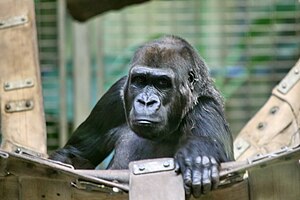
Back بوابة:جمهورية إفريقيا الوسطى Arabic Portal:República Centroafricana Spanish Portail:République centrafricaine French Portal:República Centro-Africana Portuguese Портал:Центральноафриканская Республика Russian باب:وسطی افریقی جمہوریہ Urdu
The Central African Republic Portal
The Central African Republic (CAR), formerly known as Ubangi-Shari, is a landlocked country in Central Africa. It is bordered by Chad to the north, Sudan to the northeast, South Sudan to the east, the Democratic Republic of the Congo to the south, the Republic of the Congo to the southwest, and Cameroon to the west. Bangui is the country's capital and largest city, at the border with the Democratic Republic of the Congo. The Central African Republic covers a land area of about 620,000 square kilometres (240,000 sq mi). , it had an estimated population of around 5.5 million. , the Central African Republic is the scene of a civil war, which has been ongoing since 2012. Most of the Central African Republic consists of Sudano-Guinean savannas, but the country also includes a Sahelo-Sudanian zone in the north and an equatorial forest zone in the south. Two-thirds of the country is within the Ubangi River basin (which flows into the Congo), while the remaining third lies in the basin of the Chari, which flows into Lake Chad. What is today the Central African Republic has been inhabited since at least 8,000 BCE. The country's borders were established by France, which ruled the country as a colony starting in the late 19th century. After gaining independence from France in 1960, the Central African Republic was ruled by a series of autocratic leaders, including an abortive attempt at a monarchy under the regime of Jean-Bedel Bokassa. By the 1990s, calls for democracy led to the first multi-party democratic elections in 1993. Ange-Félix Patassé became president, but was later removed by General François Bozizé in a 2003 coup. The Central African Republic Bush War began in 2004 and, despite a peace treaty in 2007 and another in 2011, civil war resumed in 2012. The civil war perpetuated the country's poor human rights record: it was characterized by widespread and increasing abuses by various participating armed groups, such as arbitrary imprisonment, torture, and restrictions on freedom of the press and freedom of movement. (Full article...) Selected article - The wildlife of the Central African Republic is in the vast natural habitat in the Central African Republic (CAR) located between the Congo Basin's rain forests and large savannas, where the human density was smaller than 0.5 per km2 prior to 1850. The forest area of 22.755 million, considered one of the richest storehouses of wildlife spread over national parks, hunting reserves and community hunting areas, experienced an alarming loss of wildlife because of greed for ivory and bushmeat exploitation by hunters – mostly Arab slavers from across the borders of the Central African Republic with Chad and Sudan. Realizing the serious threat to the wildlife, the colonists – French administration – in 1935 and later the government of the CAR, enacted laws and created national parks and preserves, which covered 16.6% of the country. The three most coveted national parks are the Manovo-Gounda St. Floris National Park with its reported "greatest concentrations of hippos in the world", the Bamingui-Bangoran National Park in the north; and the Dzanga-Sangha Reserve which covers rain forests. The Manovo-Gounda-Saint-Floris National Park, in particular was inscribed to the UNESCO List of World Heritage Sites in 1988 in recognition of the diversity of life present within it in respect of its wealth of flora and fauna. In 2014, the Chinko Nature Reserve in eastern CAR was granted management through a public-private partnership with the Central African Republic Ministry of Wildlife, Water and Forestry and African Parks, a conservation NGO that takes on the direct, long-term management of national parks and protected areas in partnership with governments to save wildlife, restore landscapes and ensure sustainable livelihoods for local communities. African Parks has a mandate to manage this protected area, now referred to as the Chinko Project, for the next 50 years. (Full article...)General images -The following are images from various Central African Republic-related articles on Wikipedia.
MapDid you know (auto-generated)
Entries here consist of Featured articles and Good articles, which consist of high-quality content on English Wikipedia..
Barthélemy Boganda (c. 1910 – 29 March 1959) was a Central African politician and independence activist. Boganda was active prior to his country's independence, during the period when the area, part of French Equatorial Africa, was administered by France under the name of Oubangui-Chari. He served as the first Premier of the Central African Republic as an autonomous territory. Boganda was born into a family of farmers, and was adopted and educated by Roman Catholic missionaries after the deaths of his parents. In 1938, he was ordained as a Roman Catholic priest. During World War II, Boganda served in a number of missions and afterwards was persuaded by the Bishop of Bangui to enter politics. In 1946, he became the first Oubanguian elected to the National Assembly of France, where he spoke out against racism and the abuses of the colonial regime. He then returned to Oubangui-Chari to form a political organisation, culminating in the 1949 foundation of the Movement for the Social Evolution of Black Africa (MESAN), which became popular among villagers and the peasantry. Boganda was laicized from the priesthood after developing a relationship with and eventually marrying Michelle Jourdain, a parliamentary secretary. Nonetheless, he continued to advocate for equal treatment and fundamental rights for blacks in the territory well into the 1950s. As France conceded measures of representation to its colonies, MESAN won local elections and he gained influence in Oubangui-Chari's government, though his reputation suffered when he backed an unsuccessful economic scheme. (Full article...)CategoriesWikiProjectsRelated portalsCities
* not the capital of the prefecture
TopicsAssociated WikimediaThe following Wikimedia Foundation sister projects provide more on this subject:
Discover Wikipedia using portals | ||||||||||||||||||||||||||||||||||||||||||||||||||||||||||||||||
© MMXXIII Rich X Search. We shall prevail. All rights reserved. Rich X Search




























































